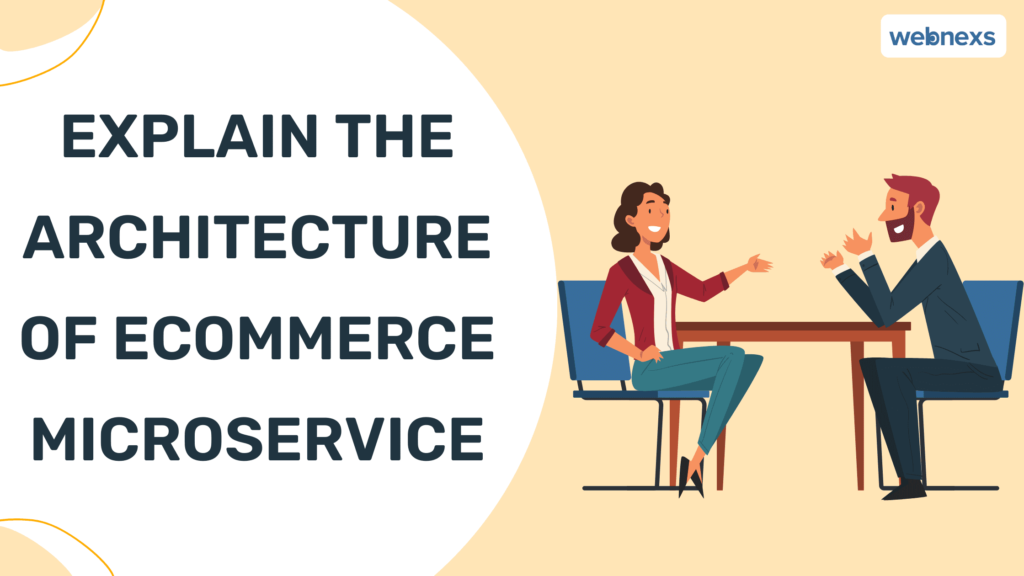Do you know the Ecommerce Microservices Architecture? This blog will describe the ecommerce microservice and its examples and full explanation. It is beneficial to all retail business owners & e-commerce merchants.

Understanding Ecommerce Microservices Architecture
A microservices structure helps build online store applications with separate components, or micro-services, linked together using REST APIs. It can use the same microservices on the back end to create many user interfaces.
Microservices, are a technique for creating software systems that combine multiple apps. Consider them LEGO bricks that can stack together to form a complete system.
“microservices” refers to each software application as a small independent service. The benefit of this type of organization is that it can adjust each service independently without interrupting the others.
Because it is a cloud-based system, a microservices form is based scalable and can avoid the limitations of a codebase.
Visit Here: What is Headless Commerce Microservices?
Benefits Of Using Ecommerce Microservices Architecture
With changing customer demands, the rise of the mobile web, and ever-shorter innovation cycles, merchants must guarantee that they have an operational and technological structure that allows for agility and speed. Speed is now a critical competitive differentiator.
Monolithic e-commerce applications, which continue to power most of the world’s largest retailers websites, are becoming bottlenecks for innovation.
Advantages of Microservices Architecture
Reduced Software Complexity:
A single microservice contains limited functionality. It makes maintenance and updating much more manageable. You only need to worry about messages from other microservices to which you have a sign (inputs) and your API, which can be called (outputs).
Specialization:
Microservices enable you to select the best tool for the job. Each microservice can have its language, framework, or ancillary services preferred by the team. Java, for example, could be used by developers for services requiring extensive background calculation. Others may rely on more lightweight technologies such as PHP or Ruby.
Faster Time To Market:
Creating a microservice necessitates a multidisciplinary development team that works independently on their project. It reduces team synchronization efforts and allows for significantly quicker deployment.
For example, the product and service team can work independently, making adjustments and automating deployments as needed – regardless of what the payment team is currently working on.
Increased Stability:
A business application comprised of a collection of microservices has no single point of failure. If one service stops responding, the application does not automatically fail.
You can, for example, continue watching movies on Netflix even if the search is unavailable. Maintenance and failure will not have the same impact on users as they would with a monolithic architecture.
Highly Scalable:
Microservices are small and identity. It makes it easier to scale them vertically and improve business application performance. It can deploy business-critical services across multiple servers for increased availability and performance.
Difference Between Microservices Architecture and Traditional Architecture
In a few key ways, ecommerce microservices architecture differs from traditional web architecture. Begin, microservices are made up of small independent networks and platforms with one another via APIs.
It gives conventional web architectures more flexibility and scalability. Second, the architectures of ecommerce microservice are responsible for fixing.
Finally, ecommerce microservices architectures are enhanced to be scalable. It means that new services can be added or removed without interrupting the system overall.
Reasons For Migrating To Microservices And Headless Commerce
Headless ecommerce refers to separating an e-commerce solution’s front-end and back-end. In another sense, the back-end is entirely separate from the front-end, allowing multiple front-end technologies to communicate with a single back-end.
Microservices are software architecture in which large applications are up of short, self-contained services. This software development method encourages modularity and scalability while allowing for frequent deployments.
1. High front-end traffic does not affect the back-end
One distinct advantage of a microservices architecture is that It can scale the front-end and back-end separately. Developers can add services were they without having to change the entire system. Heavy traffic on the front end does not affect back-end operations.
2. Increased customization and personalization options
A headless system allows you to connect multiple front-ends to a single back-end system. It opens up possibilities for adding a slew of new front-end touchpoints.
3. Get what you need
A monolith is a feature-rich, all-in-one system, but you may find yourself paying for and working around features and functionality your company does not require. Each microservice in a microservices approach serves a business function.
You can only add what you will use to your system, resulting in a leaner and more efficient technology stack.
4. The technology stack allows for quick implementation
Because microservices ecommerce architecture or headless systems create a distributed way, it is easier for developers from different teams to collaborate to modify the code base and get to market faster.
Visit Here: Headless Commerce Architecture: The Future Starts Here In 2024
How Can Microservices Ecommerce Architecture Can Be Used?
There is no answer to this question because the best way to use an e-commerce microservices structure depends on the business’s specific needs and goals.
1) To divide the large e-commerce platform into smaller, more manageable components.
2) Create a more scalable e-commerce platform to handle traffic and demand spikes more effectively.
3) To create a more adaptable e-commerce platform that can be easily customized and adapted to meet the changing business needs.
4) Create a more robust e-commerce platform with less downtime and performance issues.
There are some little surprises waiting for you, and that is the disadvantage of the e-commerce microservices architecture. Not as much as you think, but there is some here they are:
Disadvantages Microservices Architecture
Higher Complexity
Microservices have a lot of benefits, but they are also more complex.
Increased Network Traffic
Microservices are primarily dependent on the network for communication because they are created to be self-contained units.
Dependency on DevOps
An effective DevOps team must be in place for organizations to succeed with microservices.
Conclusion
Microservice architectures are gaining popularity in the software industry. Microservices are a type of architecture that aims to improve scalability and maintainability. This article describes how microservices can help you develop a scalable and maintainable headless ecommerce application.
If you have any doubts or queries, feel free to contact us. We will help you to increase sales.

